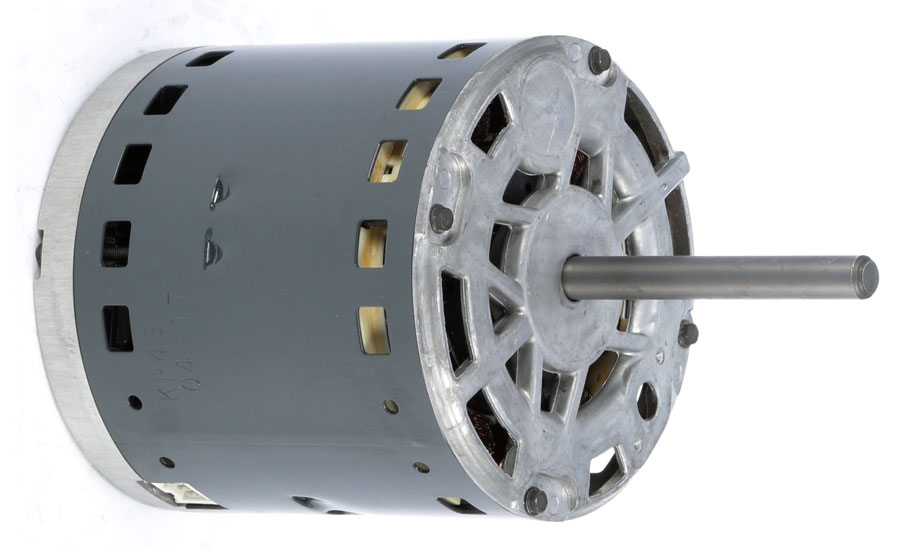As a part of its Energy Conservation Program for consumer products, the Department of Energy (DOE) establishes energy efficiency standards for many appliances used daily in American households. Prior to 2014, the DOE had not issued any new energy efficient furnace regulations for decades nor were there any federal energy conservation standards for residential furnace fans. In 2014, all that changed when the DOE announced national efficiency standards that specify a maximum fan energy rating (FER) for furnace fans that will take effect July 3, 2019. FER is the amount of electricity needed to move a cubic foot of air per minute (watts/cfm).
This new furnace fan standard is a first for the DOE, which, up until now, has regulated the system-based performance of HVAC units, not the energy efficiency of individual components. Furnaces are already tested for gas efficiency (AFUE) and electrical efficiency (SEER) as part of a total system analysis.
The goal of this mandate is to reduce energy consumption in furnaces by approximately 40% in 30 years, equivalent to 500 billion kilowatt hours, an amount equal to the annual electricity use of about 47 million U.S. households. It will save consumers $29 billion over the next 30 years. Additionally, the energy savings from the new standards will translate to reductions in CO2 emissions of about 180 million metric tons over the same time period.
These mandates often result in manufacturers developing innovative technology and products, and this one is no exception. Let’s examine the residential furnace industry and how cutting-edge engineering is driving new fan motors.
Manufacturers and Compliance
To comply with the new standards, manufacturers have been redesigning products that do not currently meet the regulation. Balancing feasibility, affordability, and reliability will be the biggest challenge for motor manufacturers.
A study conducted by the International Energy Agency shows that electric motors consume 45% of electricity globally. Electric motors will continue to be a focus for regulation, but recent dialogue has focused on system efficiency. Even the furnace fan regulation is part of the system efficiency standard as factors such as the blower and the cabinet design factor into the FER.

With many of the newly engineered ECMs, manufacturers are making it easier than ever to install or diagnose any problems.
Residential Furnaces and Fans
Furnace fans consume about 1,000 kilowatt-hours per year, or almost 10% of the total electricity use of an average U.S. home. Furnaces are one of the largest energy consuming appliances in the home. Furnace fans, which circulate heated and cooled air throughout a home, consume more than twice the electricity in a year as a typical new refrigerator.
Many of today’s residential furnaces operate with permanent split capacitor (PSC) motors. However, with this mandate, furnace manufacturers are re-engineering furnaces to now use electronically commutated motors (ECM), which represent an advance in blower motor efficiency that saves substantial energy and improves aspects of overall system performance.
There are a number of benefits of an ECM motor: unlike an on/off PSC motor, a furnace ECM motor can operate at a range of outputs between zero and 100%; output of the motor can be adjusted by signals from a controller, or permanently programmed to advance through a range of speeds during each on cycle of the furnace; an ECM delivers efficiencies in the range of 65 or 75%, depending on the output. A PSC motor, on the other hand, has efficiencies of only about 45%. Because a furnace ECM motor runs a longer cycle at a lower output most of the time, heating and cooling is more consistent and rooms avoid the temperature spikes and sags common with on/off PSC blowers.
Additionally, ECMs provide a soft start feature that reduces the common “clunk” start-up noise experienced when using PSC motors. The hum and the speed transition noises are also greatly reduced with the use of the ECM motor. ECM retrofit motors operate at constant fan speeds for a much lower cost, enabling the homeowner to use this as the default. Efficiency is a significant advantage, with an average 25% reduction in watts used in operating mode and 74% less in constant fan mode.
Contractors
The vast majority of existing residential furnaces use relatively inefficient PSC motors. It is important to remember that, any time the blower motor is replaced, the operation in heating and cooling must be checked to ensure that it meets the OEM’s specification, and the new DOE standards, with the new motor installed.
Often, contractors are hesitant to work with new technology. Newly designed HVAC systems include a higher level of electronics and system integration that must be supported by the contractor in the field. The increased complexity requires more training to ensure the equipment can be effectively maintained and serviced.
With many of the newly engineered ECMs, manufacturers are making it easier than ever to install or diagnose any problems. And, since new furnaces will include ECMs, technicians need to understand the technology in order to service the equipment.
While the DOE’s new standard does not require contracts to retrofit PSC motors in homeowners’ furnaces, to help reduce energy costs and consumption it just makes sense to install a high-efficiency ECM fan motor.
Cutting-Edge Technology
Manufacturers are now integrating high efficiency with smart controls directly into the motor. This technology enables technicians to use their phones to receive real-time maintenance alerts and diagnostic information, and conduct remote programming.
Some of the most innovative motor technology integrates near field communication (NFC), which allows for programming without even powering the motor. Specifically, NFC is a way for a phone or similar device to interact with something in close proximity. It provides a wireless connection, without relying on Wi-Fi, 3G or LT, between devices, permitting communication to be sent and received.
Additional product features on some new ECM motors include sensorless sine drives that help reduce noise levels. The motors are designed to be shorter, which lessens airflow restriction, and with spoked rotors that improve reliability. Manufacturers are also engineering these motors to be lighter in weight, which reduces furnace companies’ transportation costs.
For higher-end furnaces, HVAC manufacturers are integrating an all-in-one blower motor system into their units. This all-in-one system combines a high efficiency blower housing, axial flux and variable speed ECM technology into one, innovative assembly; delivering higher efficiencies, improved airflow, and lower maintenance costs. Additionally, this revolutionary system puts out an average of 2-3 dB less than comparable systems.
These latest innovations allow equipment manufacturers to create forced-air systems that are more advanced, provide greater reliability, and are easier to service. Some systems, utilizing the latest motors, have fewer set-up steps because the motor enables true plug-and-play self-recognition software and a user interface that can control system, set-up and troubleshooting.
Interest and growth in connected products that help homeowners maintain and manage their homes’ energy usage has been the driving force for these innovative products and cutting-edge technology. With smarter systems and more advanced technology, consumers are the winners. And, when upgrading to a new furnace, choosing a model with an energy efficient motor can save 20 to 50% of the energy needed to continuously operate a fan motor.
Conclusion
The DOE’s energy conservation standards provide manufacturers an opportunity for the best, most cost-effective, and most reliable solutions to be implemented throughout the industry. According to the U.S. Energy Information Agency, heating and cooling accounts for 48% of the energy used in a typical office or home. By educating consumers about installing either new furnaces or retrofitting outdated PSC fan motors with cutting-edge and energy-efficient ECM motors, homeowners can have a dramatic impact on lowering energy consumption and reducing their carbon footprint.
As consumers increasingly want to pursue sustainable practices and reduce energy costs, there are many simple and affordable strategies. As this article illustrates, one strategy is the adoption of innovative technology, such as new ECM motors, which reduce energy consumption without sacrificing comfort.
References
- https://appliance-standards.org/product/furnace-fans (accessed January 3, 2018).
- Zachary Shahan, “Electric Motors Use 45% of Global Electricity, Europe Responding,” June 16, 2011, Cleantec.com.
- www.neo.ne.gov/neq_online/aug2014/aug2014.04.htm (accessed January 3, 2018).
- www.griffithenergyservices.com/article/your-furnace-replacement-the-ecm-motor-vs-the-psc (accessed January 3, 2018).
- www.thedealertoolbox.com/industry-news/achieving-energy-efficiency-and-comfort-with-psc-motor-replacements/ (accessed January 3, 2018).
- https://energy.gov/public-services/homes/heating-cooling (accessed January 3, 2018).



